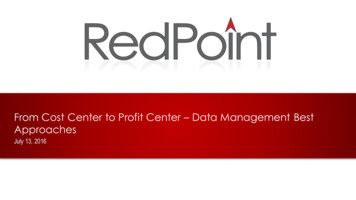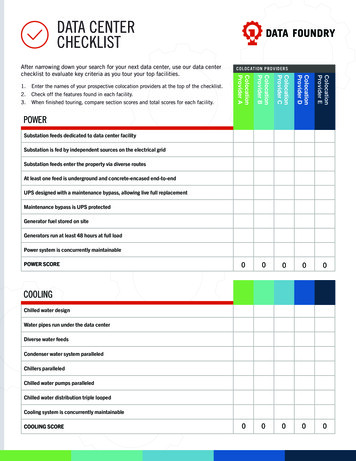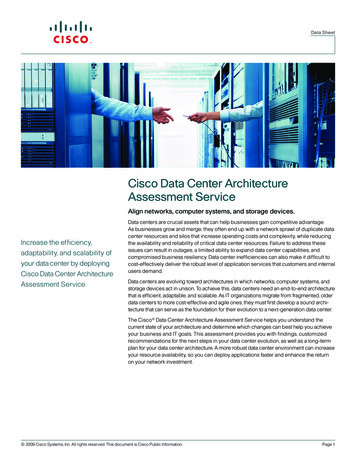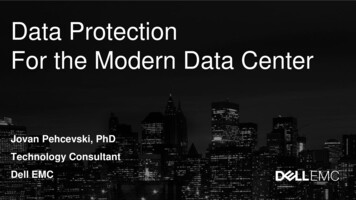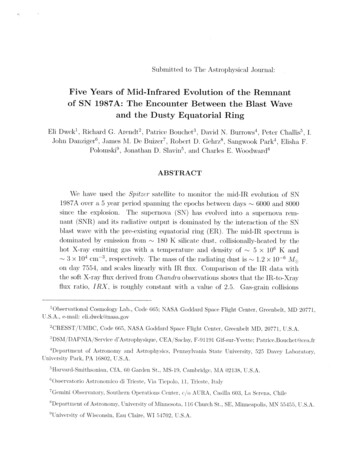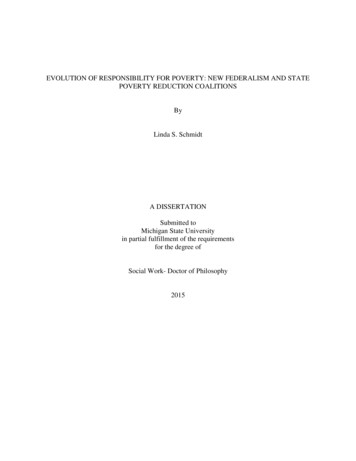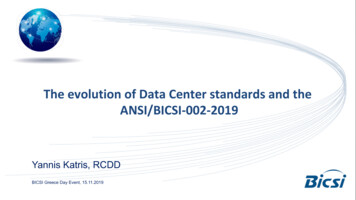
Transcription
The evolution of Data Center standards and theANSI/BICSI-002-2019Yannis Katris, RCDDBICSI Greece Day Event, 15.11.2019
Data Center standards and certifications Standards are important to guide data centre design andlegitimately compare sites. The (main) reason for a Data Center: continuity of services,availability. The principles of design and management of Data Centers are thesame wherever you are. Data Center certification against standards is a confused andunregulated space.Yannis Katris, RCDD Athens 15 November 2019
Data Center standards & related documentsDevelopment of European Green Public Procurement Criteria for Data CentresEuropean Commission, JRC Technical Reports, Version 1.0, October 2017 Open Standard for Datacenter Availability (OSDA); TheGreen Grid’s No.71 White PaperThe Green Grid Maturity Model (DCMM)ANSI/TIA-942-BUptime Institute’s Tier Classification SystemEN 50600 SeriesISO/IEC 30134 series (aligned to the EN50600)ISO 14001 (environmental management system)ISO 50001 (operational energy management system)ETSI DCEM (Data Centre Energy Management)ITU Toolkit on Environmental Sustainability for the ITSector (ESS)European Catalogue of IT Standards for ProcurementUS Energy STAR benchmarking of data centresYannis Katris, RCDD Athens 15 November 2019 EU Code of Conduct (CoC) for Energy Efficiency in DataCentresEU Code of Conduct for AC uninterruptible powersystems (UPS)The Blue Angel energy efficient data centre operationEU Eco-Management and Audit Scheme (EMAS)Finnish sustainability rating system (TIKO) for datacentres by Ministry of Transport and CommunicationsEU Procurement guidance PrimeEnergyIT projectEURECA project on data centresGreen Public Procurement Criteria for Office BuildingDesign, Construction and ManagementANSI/ASHRAE Standard 90.4-2016BREEAM, LEED, ISO 14062, EN 15804, .
Data Center standards & documents – most known ASHRAE - TC 9.9 2015 The environmental metricsUptime Institute: Tier Standard – TopologyANSI/TIA-942-B-2017ANSI/BICSI 002-2019EN 50600ISO/IEC TS 22237ISO/IEC 11801-5:2017 [Generic Cabling – Data centers]CENELEC – EN 50173-5 [Generic Cabling – Data centers]Yannis Katris, RCDD Athens 15 November 2019
Additional standards applied to Data CentersISO 9000 series: Quality SystemISO 14000 series: Environmental managementISO 50000 series: Energy managementISO 27001: Information securityPCI: Payment Card Industry Security StandardSOC, SAS70 & ISAE 3402 or SSAE16, FFIEC (USA): Assurance ControlsAMS-IX: Amsterdam Internet Exchange - Data Centre Business ContinuityStandard EN50600-2-6: Management and Operational Information
Data Center design – coordination of tradesIT Equipment and systemsElectrical systems to and within the Data CenterVentilation, airflow, HVACFire minimization, detection, alarm andsuppression Control, monitoring and reporting Security, access and CCTV Building management systems Yannis Katris, RCDD Bucharest 3 July 2019
Regulations and Standards: What is regulation? Regulation is the way in which public authorities seek to guide orcontrol behaviours. Legislation states what individuals and businesses must do, ormust not do, and is usually backed by enforcement and thepossibility of sanctions. Compliance with legislation is mandatory; it is accompanied byenforcement mechanisms and possible sanctions whererequirements have been breached.Source: CEN-CENELEC GUIDE 30, European Guide on Standards and Regulation - Better regulation through the useof voluntary standards - Guidance for policy makersYannis Katris, RCDD Athens 15 November 2019
Regulations and Standards: What are Standards? EN 45020:2006 Standardization and related activities: The term“standard” is defined as “a document, established by consensusand approved by a recognized body, that provides, for commonand repeated use, rules, guidelines or characteristics for activitiesor their results, aimed at the achievement of the optimum degreeof order in a given context”. An EN (European Standard) “carries with it the obligation to beimplemented at national level by being given the status of anational standard "Source: CEN-CENELEC GUIDE 30, European Guide on Standards and Regulation - Better regulation through the useof voluntary standards - Guidance for policy makersYannis Katris, RCDD Athens 15 November 2019
Regulations and Standards: What are Standards? Standards are an agreed way of achieving a set objective. They may take a number of forms, including specifications forproducts, systems and services, methods of testing, terminologyand definitions, information requirements, interfaces andprocesses. Standards are developed primarily to meet the good practiceneeds of industry, businesses and other interested parties and toencourage its take-up in the broader economy.Source: CEN-CENELEC GUIDE 30, European Guide on Standards and Regulation - Better regulation through the useof voluntary standards - Guidance for policy makersYannis Katris, RCDD Athens 15 November 2019
Regulations and Standards: What are Standards? Standards are voluntary in the sense that there is no obligation tocomply with them, implement them or participate in theirdevelopment; they are tools for market players. The primary objective of standardization is the definition ofvoluntary technical or quality specifications (REGULATION (EU) No 1025/2012 OFTHE EUROPEAN PARLIAMENT AND OF THE COUNCIL of 25 October 2012 on European standardisation) Making in legislation an indirect reference to a standard is stronglyrecommended by CEN and CENELEC; (flexibility: Standards will be updated whenrequired, responding to market needs and without necessitating changes to legislation)Source: CEN-CENELEC GUIDE 30, European Guide on Standards and Regulation - Better regulation through the useof voluntary standards - Guidance for policy makersYannis Katris, RCDD Athens 15 November 2019
The differences between standards and legislationLegislation (Technical Regulation)MandatoryCreated by legislatorStandardsVoluntaryDeveloped by interested parties throughprivate standardization organizations processesConsultation depending on public authorities’policiesFull open and transparent public consultationDecided by legislatorBased on consensus of interested partiesRevised when legislator decidesConsidered for revision at least every 5 years
RegulationsPublicaly availableLawsPublic standardsIndustry standards / guidelinesCompany standards / guidelinesLimited availabilityGovernment regulatedSelf regulatedLaws, Regulations, Standard: positioning in the marketand impact
ANSI/TIA-942-B-2017Telecommunications Infrastructure Standard for Data CentersYannis Katris, RCDD Bucharest 3 July 2019
ANSI/TIA-568 series standards
ANSI/TIA-942-B-2017 Sections Data Center Design overview Cabling system infrastructure Telecommunications spaces andrelated topologies Cabling systems Cabling pathways Data center redundancy (Cabling) Cabling installation requirements(ANSI/TIA-568.0-D) Cabling transmission performancerequirementS (ANSI/TIA-568.0-D, -568.3-D,-568.4-D)Yannis Katris, RCDD Athens 15 November 2019 Cabling for intelligent building systems(ANSI/TIA-862-B) Cabling for wireless access points (TIATSB-162-A) Cabling for DAS (TIA TSB-5018) Power delivery over balanced twistedpair (TIA TSB-184-A) Grounding and bonding (ANSI/TIA-607-C) Firestopping (ANSI/TIA-569-D) Physical security (ANSI/TIA-5017) Administration (ANSI/TIA-606-C) * Array connectivity& AIM Automated Infrastructure Management per the ANSI/TIA-5048
ANSI/TIA-942-B-2017 Annexes (informative) Cabling designconsiderations Access provider information Coordination of equipmentplans with other engineers Data Center spaceconsiderationsYannis Katris, RCDD Athens 15 November 2019 Data Center site selection andbuilding design considerations Data Center infrastructure rating Data Center design examples Cabling guidelines for DataCenter fabrics
ANSI/TIA-942-B-2017 Annex F Rating Rated-1 Data Center: BasicRated-2 Data Center: Redundant componentRated-3 Data Center: Concurrently maintenableRated-4 Data Center: Fault tolerant A data center may have different ratings for different portions ofits infrastructure (Telecommunications, Architectural, Electrical,Mechanical).– For example, a data center may be rated T2 E3 A1 M2Yannis Katris, RCDD Athens 15 November 2019
ANSI/TIA-942-B-2017 Annex F Rating
CENELEC EN 50600 series Information technology – Datacentre facilities and infrastructures Overview:– EN 50600-1: 2019 - Part 1: General concepts Design:EN 50600-2-1: 2014 - Part 2-1 : Building constructionEN 50600-2-2: 2019 – Part 2-2: Power distributionEN 50600-2-3: 2019 – Part 2-3: Environmental controlEN 50600-2-4: 2015 – Part 2-4: Telecommunications cablinginfrastructure– EN 50600-2-5: 2016 – Part 2-5: Security systems––––
CENELEC EN 50600 series Information technology – Datacentre facilities and infrastructures Operations and Management:– EN 50600-3-1: 2016 - Part 3-1 : Management and operationalinformation KPIs– EN 50600-4-1: 2016 – Part 4-1 : Overview of and generalrequirements for key performance indicators– EN 50600-4-2: 2016 – Part 4-2: Power Usage Effectiveness– EN 50600-4-3: 2016 – Part 4-3: Renewable energy factorEN 50600 is written as a guideline.
CENELEC Technical Reports Best practices– CLC/TR 50600-99-1:2018: Information technology - Data centrefacilities and infrastructures - Part 99-1: Recommended practices forenergy management.– CLC/TR 50600-99-2:2018: Information technology - Data centrefacilities and infrastructures Part 99-2: Recommended practices forenvironmental sustainability– CLC/TR 50600-99-3:2018: Information technology - Data centrefacilities and infrastructures Part 99-3: Guidance to the applicationof EN 50600 series
EN 50600 Availability Classes Apply to: Power supply & distribution, Environmental control, TelecommunicationscablingClass 1 Low availability. Design without redundancies based on a supply pathClass 2 Extended availability. Design with partial redundancies based on a supply pathHigh availability. Design with redundant components based on two supply paths (butClass 3only one refrigeration supply path)Very high availability. Design with system redundancies based on two supply pathsClass 4(but only one refrigeration supply path)The protection Zones (1, 2, 3, 4) characterize data center spaces with respect to physical accessprotection, fire protection, defense against hazards from inside, defense against hazards fromoutside.Energy efficiency Levels (1, 2, 3)
ISO/IEC 22237 seriesISO/IEC TS 22237-1:2018 – Part 1: General concepts;ISO/IEC TS 22237-2:2018 – Part 2: Building construction;ISO/IEC TS 22237-3:2018 – Part 3: Power distribution;ISO/IEC TS 22237-4:2018 – Part 4: Environmental control;ISO/IEC TS 22237-5:2018 – Part 5: Telecommunications cablinginfrastructure; ISO/IEC TS 22237-6:2018 – Part 6: Security systems; ISO/IEC TS 22237-7:2018 – Part 7: Management and operationalinformation.
ANSI/BICSI 002-2019Data Center Design and Implementation BestPracticesYannis Katris, RCDD Bucharest 3 July 2019
ANSI/BICSI 002-2019 1.2 Purpose– For: Data Center owners and operators Telecommunications and IT consultants and project managers Telecommunications and IT technology installers– Users within IT may use BICSI 002 in conjunction with the appropriate localtelecommunications infrastructure standard (e.g., ANSI/TIA-942-B, AS/NZS 2834-1995Computer Accommodation, CENELEC EN 50173 Series, ISO/IEC 24764) to design thetelecommunications pathways, spaces, and cabling system for the data center – Users within facilities group as a guide – Staff outside IT and facilities groups (Physical security management, constructionfirms, Telecommunications consulting firms)Yannis Katris, RCDD Athens 15 November 2019
ANSI/BICSI 002-2019ANSI/BICSI 002-2011Yannis Katris, RCDD Athens 15 November 2019ANSI/BICSI 002-2019
ANSI/BICSI 002-2019 Sections Site selectionSpace planningArchitecturalStructuralElectrical systemsMechanical systemsFire ProtectionSecurityYannis Katris, RCDD Athens 15 November 2019 Facility, ancillary and IP-enabledsystems Telecommunications cablinginfrastructure, pathways andspaces Information technology Commisioning Data Center maintenance
ANSI/BICSI 002-2019 Appendixes (informative) Design process Reliability and availability Alignment of Data Center services reliability with application and systemarchitecture Data Center services outsourcing models Multi-Data Center Architecture Examples of testing documentation Design for energy efficiency Colocation technical planning Related documentsYannis Katris, RCDD Athens 15 November 2019
ANSI/BICSI 002-2019 Class Ratings The five Classes are:– Class F0 - a single path data center that meets the minimumrequirements of the standard, but doesn’t meet the requirements ofan F1 or higher level data center– Class F1 - the single path data center– Class F2 - the single path data center with redundant components– Class F3 - the concurrently maintainable and operable data center– Class F4 - the fault tolerant data centerYannis Katris, RCDD Athens 15 November 2019
ANSI/BICSI 002-2019
ANSI/BICSI 002-2019
ANSI/BICSI 002-2019 Classes, examplesYannis Katris, RCDD Athens 15 November 2019
ANSI/BICSI 002-2019 - Classes, examples
BICSI Standards and Manuals complement nationalstandardsSource: What do DCDCs do? And how they relate to the ANSI/BICSI002 standard? – Rui Takei, RCDD, DCDC
Data Center certification Uptime Institute––––Tier Certification of Design DocumentsTier Certification of Constructed FacilityTier Certification of Operational SustainabilityAditional ratings: gold, silver, bronze Tier-Ready Program (2017 - for prefabricated and modular data centers)
Standards fall into three broad categories Components, assembly
Best practices – . Data Center Design and Implementation Best Practices 1.2 Purpose – For: Data Center owners and operators Telecommunications and IT consultants and project managers Telecommunications and IT technology installers – Users within IT may use BICSI 002 in conjunction with the appropriate local telecommunications infrastructure standard (e.g., ANSI .

